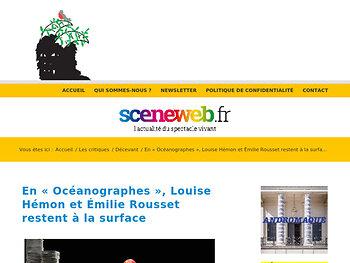In "Oceanographers", Louise Hémon and Émilie Rousset stay on the surface<
© Ph. Lebruman
On her return from six months spent aboard a trawler, from July to December 1952, Anita Conti, already nicknamed the "Lady of the Sea", brought back a unique account of life at sea: texts, which she collects and publishes under the title of Racleurs d'océans, his first book, but also images. Leaving with a camera, she films the sixty men on board in all their activities: in fishing of course, in the cutting up of their small and very large prey – some stomachs sink like erupting volcanoes –, and in occupations whose banality is completely transcended by the setting in which they take place. A simple haircut is thus an adventure in which the comic vies with the epic. Between two daily scenes, the sailors also appear masked in a strange way. They engage in a ceremony that Louise Hémon and Émilie Rousset explain in the dossier of their show Les Océanographes: this film, titled in the same way as the book cited earlier, they say, "shows images of sailors disguised as gods Neptune and penguins”. It is a "baptism of Neptune, a codified and carnivalesque outlet party".
This very theatrical part of Anita Conti's film, which she never had time to edit – she presented it at conferences, as support for her oral testimony – undoubtedly contributes to the interest that arouses in Louise Hémon and Émilie Rousset. She is far from fully explaining it. It is while working on their film Ritual 3: The Baptism of the Sea (2016), part of a series of short documentary films and performances on the rites of our society that they have been making together since 2015, that the director and the director discovers the archive: they see there the trace of an exceptional woman whose thought and work have been largely invisible. This Anita Conti that we never see in the film Scrapers of Oceans, that we don't hear, but that we guess is for many years the nature of the images, in their force and their effect of truth .
Outside the framework of the Rituals, Les Océanographes testifies to the fascination exerted by the pioneer of oceanography and maritime ecology on the two artists. A fascination that turns out to be paralyzing. In the middle of piles of sheets of paper that fly away in a kind of minimalist, all-white banns – the scenography is by Nadia Lauro – the actress Saadia Bentaïeb immediately expresses the difficulty of the two authors and directors of the play to overcome their archives, to compose a personal language from them. In her way of carrying snippets of the book Racleurs d'océans, between incarnation and the simple sharing of a word, Saadia Bentaïeb announces the failure of Louise Hémon and Émilie Rousset to mix theater and documentary cinema to say something about world today. She also speaks of their difficulty in questioning, as they usually do, the two modes of expression that they like to create a dialogue, to intertwine.
Spanish Adverbs - How to Use Them WITHOUT More Rules https://t.co/YUTQiC3Won via @YouTube I've really learned about… https://t.co/KTUzAaFEqj
— ria Thu Feb 28 10:13:02 +0000 2019

As scientifically rich as they are intimate – her humor and way of handling words attest to an extraordinary personality – Anita Conti's words exert a stifling hold on the set rather than a creative impulse. The distorted sound of the Marthenot wave played live by Julie Normal, one of the rare musicians in the world to master this instrument, is not enough to create a density equivalent to that which one feels when playing the text or watching Anita Conti's film. Which is also projected in the middle of the show, after the performance of Saadia Bentaïeb and before that of Antonia Buresi who takes over to give the voice of a contemporary oceanographer, built from meetings with scientists from 'today. The presence within the room of almost the entire film seems like an admission of failure.
For lack of having found how to transform, how to appropriate the materials that fascinated them, Louise Hémon and Émilie Rousset are content to show them in a raw way. Their Oceanographers therefore navigate between the portrait of a woman from the past and the militant spectacle. In the second part of the show, we indeed find the same alerts of an ongoing ecological disaster, the same battles. Because in addition to studying the men and animals of the sea, Anita Conti was one of the first to work on the design of an ecological trawler. What women and men continue to do today, with today's technologies. All the more reason to make us regret never embarking on the journey proposed by these Oceanographers.
Anaïs Heluin – www.sceneweb.fr


 Tags:
Tags: Prev
Prev







